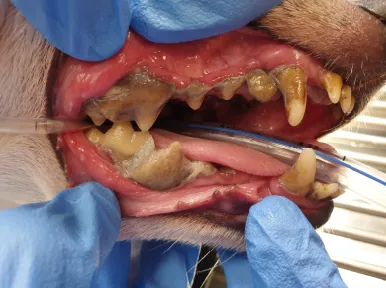
Dentistry Service
Periodontal Surgery
WAVES HOSPITAL
Periodontal Disease
Periodontal disease is the most common infectious disease affecting dogs and cats in the world. In fact, 85% of pets over 3 years of age suffer from periodontal disease. The word periodontal means “around the tooth”. The periodontal tissues are the gingiva, the periodontal ligament, the cementum and the alveolar bone. Periodontal disease can be limited to the gingiva or can extend to deeper layers to cause periodontitis (bone loss).
UNMATCHED EXPERTISE
Periodontal Disease
Periodontal disease is the response from your immune system to the accumulation of plaque on the tooth surfaces. Plaque is a mixture of food particles, saliva and bacteria. This material attaches to the surface of the teeth and needs to be removed mechanically (e.g. brushing of the teeth and chewing). If it is not removed, it will mineralise to form calculus (tartar) which cannot be removed with a toothbrush. Calculus is not periodontal disease on its own, but is rather a ‘red flag’ for the existence of periodontal disease. It is the bacteria in plaque that triggers an immune response leading to tissue damage.
Similar to us, cats and dogs continuously accumulate dental plaque and calculus and can eventually develop gingivitis. The gums become inflamed and bleed easily. After prolonged periods of untreated gingivitis, the oral barrier breaks down and the deeper supporting tissues of the teeth such as bone and periodontal ligament are damaged and even destroyed (periodontitis). Gingivitis can be noted during an oral examination however the diagnosis of the presence, severity and extent of periodontitis requires dental radiographs and periodontal probing under anaesthesia.
If teeth with end-stage periodontitis are not treated in time, the bone destruction can extend beyond the tooth roots into surrounding structures. Periodontitis can extend into the nasal cavity causing sneezing when material from the mouth enters the nose, or into the eye socket, causing visible swelling around or behind the eye. It can even weaken the mandibular bone to the point of causing a pathological jaw fracture. This is most common in older small breed dogs. The end-stage of this disease is tooth loss, however, the disease has caused problems for a pet well before this.
Periodontal disease can be painful. However, it is rare that our pets will show obvious signs of oral discomfort. Once the condition is treated, many owners report that their pet is happier and more playful and even less fussy with food.
In addition to pain, bacterial toxins and inflammatory products from our pet’s own immune systems are released into the bloodstream and can damage the heart, liver and kidneys.
CONTACT OUR TEAM

TREATMENT
Treating Periodontal Disease
Treating periodontal disease often involves more than removing plaque and calculus. Dental prophylaxis (‘teeth cleaning’) is an appropriate treatment on its own when the patient does not have periodontitis and no other treatment is necessary. This determination requires dental radiographs and periodontal probing which does require a general anaesthetic. Simply performing teeth cleaning without looking for and treating any underlying disease is of little to no benefit and can even be harmful.
When periodontal disease is diagnosed, treatment involves safely cleaning the tooth roots and restoring the oral barrier. This is achieved through several types of procedures, including root planning, tissue grafting and surgical closure of sites of periodontal disease.
We assess every tooth on a case-by-case basis and in addition to other factors such as:
- Will daily dental home care be easy to perform on your pet?
- How motivated and capable are you to provide this home care?
- Is it in your pet’s best interest to receive multiple anaesthetics to solve this ongoing and progressive problem?
When periodontal disease is advanced, tooth extraction may, at times, be the only option to restore your pet’s mouth to a functional and pain-free state.
Following treatment of periodontal disease, or before it develops, beginning a daily dental home care routine, which includes tooth brushing helps to maintain good oral health, though routine professional veterinary treatment is still necessary.
Our aim is to help you keep your pet’s mouth healthy, comfortable and functional for their lifetime.
CONTACT OUR TEAM
REGISTRATION
Have a referral?
Have you been referred by a vet? Please complete the registration form.
COMPLETE FORM
Dentistry Services
Endodontics
Linguoverted
Canine Teeth
Maxillofacial
Surgery
Periodontal
Surgery
Restorative
FAQs
OUR DENTISTRY TEAM
Meet Our Dentistry Team
Brace yourself. We are a team like no other. No fill-ins or tooth faries here, just vets who like the tooth, the whole tooth and nothing but the tooth. Our patients can't read our plaques. Molar bears, vampurrs and canines, we'll treat them all. A functional, pain-free mouth for your pet is our floss-ophy. You know the drill.... click on the link and check us out...let's see if we can get to the root of your pet's problems. It might just be love at first bite.
SAY HELLO
DEPARTMENTS
Specialties & Services
CONTACT US
Veterinary Referral & Emergency Services
CONTACT US
